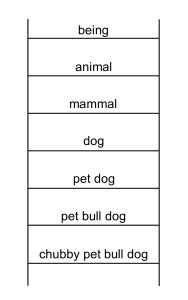Specificity
The ability to be specific is one of the most overlooked skills in writing, yet it might be one of the most valuable. Being specific, or the strategy of specificity, is especially important when using examples to help readers better understand what you mean. This also happens to be a skill that takes longer for students to improve than other similar skills, so patience and persistent practice are key.
The Ladder of Abstraction
One useful model of thought to aid in specificity is the Ladder of Abstraction, proposed by S.I. Hayakawa in his book Language in Thought and Action. It is a way of visualizing a type of idea as a vertical ladder, and visualizing the different words for the idea as rungs on that ladder. The higher the rung, the more that word is abstract, general, or vague. The lower the rung, the more that word is specific, particular, or detailed. Example:

Words that are high in abstraction are open to interpretation but lack guidance about which interpretation the writer means. Words low in abstraction–more specific words–present more precise images or ideas. It is important to realize that your readers can always move up the Ladder of Abstraction, but they cannot move down. This means that if you give them the specific phrase “my chubby pet bull dog,” reader can also understand that you’re conveying the idea of a pet, a dog, a mammal, or a being in general. But if you were to give them the mildly abstract word “dog,” or the more abstract word “mammal,” reader can never be expected to correctly interpret your meaning of “chubby pet bull dog.” So in order to more clearly convey your ideas, you need to get specific.
The Five Senses
Another model of thought to aid in specificity is an ancient one: Aristotle’s model of the human being as having five senses. They are commonly identified as sight, sound, touch, taste, and smell.
Describing an example that employs the use of these senses is a way to be specific. Or another way of looking at it is this: if what you are describing can be filmed, listened to, or touched, it is likely to be specific. If it can’t be, then it’s not. This often helps writers who confuse their own abstract expressions with the more specific images they have in mind but haven’t yet articulated.
For example, many students identify the word “happiness” as specific. But can you see “happiness”? Can it be filmed? This is often where students refer to a “smile,” but that was not the word in question. “Smile” is specific; it can be seen, filmed, etc. But “happiness” is not; it is abstract. You cannot see happiness, or hear it, or touch it, taste it, or smell it. You could only use those senses for more specific instances of happiness, such as smiling, laughter, an so on.
Of course, you don’t always need to employ the strategy of specificity. You will often want to make general statements, and you definitely want the ability to move from abstract to specific to suit your changing needs as a writer. But when it comes time to clarify exactly what you mean, especially when giving examples, focus on specificity.
Exercise 1
Identify which option in each of the following groups of three is the most specific. Note that this is not just a matter of interpretation, but it is nonetheless a matter of critical thinking: there are right and wrong answers that require careful interpretation to identify.
1.
a. Fighting for freedom and for our nation
b. A veteran with a prosthetic leg
c. The American armed forces and the proud men and women who serve
2.
a. Overcoming obstacles in life
b. Taking college classes
c. Writing a five-page essay for biology class
3.
a. Jogging, yoga, and weightlifting
b. Losing weight while getting stronger and healthier
c. Improving diet and exercise
4.
a. Believing in yourself and pursuing your goals
b. Becoming a CNA and getting a full-time job with benefits
c. Working a nursing night-shift through the winter at St. Joseph’s Hospital
Exercise 2
Answer whether the following count as specific examples of the topic “something people enjoy”?
1. Hanging out with friends.
a. Yes, it is specific.
b. No, it is not specific.
2. Jet-skiing at Carlyle Lake.
a. Yes, it is specific.
b. No, it is not specific.
3. Taking part in hobbies that involve friends and family.
a. Yes, it is specific.
b. No, it is not specific.
4. Working hard, getting better every day, and following your dreams.
a. Yes, it is specific.
b. No, it is not specific.
5. Reading true-crime books about serial killers.
a. Yes, it is specific.
b. No, it is not specific.
Exercise 3
Offer a specific example for each of the following abstractions:
- Hope
- Fear
- Self-improvement
- Destiny
- Being irresponsible
